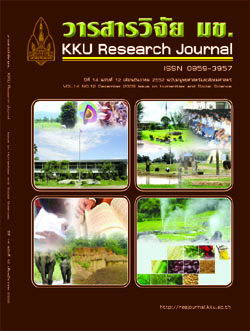Differences in academic reading strategy employment among male and female science-oriented undergraduate students with different levels of EFL reading proficiency
Main Article Content
Abstract
The present large scale study focused on an investigation of the differences in the frequency of reading strategy used by male and female students with different levels of reading proficiency when reading academic materials. Participants were 1,096 science-oriented students who enrolled in ESP courses. The researcher-constructed reading strategy questionnaire (Alpha Coefficient (∝) = 0.95) was used as the main instrument in collecting data. Results of the study reveal that most of the studentsû responses in terms of individual strategies were at the medium level. In the case of overall reading strategy use, the present study found significantly greater overall use of reading strategies among the students with high reading proficiency level, and female students. Additionally, significant differences by reading proficiency level and gender in the use of two main strategy categories (1: actual reading strategies; and 2: textual comprehension enhancement strategies) were found.
Article Details
References
Block, E. 1986. The comprehension strategies ofsecond language readers. TESOLQuarterly. 20(3):463-494.
Glass, G. V., & Hopkins, K. D. 1996. Statisticalmethods in education and psychology(3rd ed.). Boston: Allyn & Bacon.
Goh, C. & Foong, K. 1997. Chinese ESL studentsûlearning strategies: A look at frequency,proficiency, and gender. Hong Kong Journalof Applied Linguistics. 2(10): 39-53.
Green, J. & Oxford, R. 1995. A closer look atlearning strategies, L2 proficiency, andGender. TESOL Quarterly. 29(2): 261-297.
Hosenfeld, C. 1977. A Preliminary Investigation ofthe Reading Strategies of Successful andUnsuccessful Second Language Learners.System. 5(2): 11-123.
Kletzien, S. B. 1991. Strategy Use by Good andPoor Comprehenders Reading ExpositoryText of Differing Levels. Reading ResearchQuarterly. 26(1): 67-86.
Lau, K. 2006. Reading Strategy Use between ChineseGood and Poor Readers: A Think-aloudStudy. Journal of Research in Reading.29(4): 383-399.
Madsen, H.S. 1983. Techniques in Testing. Oxford:Oxford University Press.Ministry of Education. 2002. The handbook for basiceducation: Foreign language curriculum,National Education Act 2001. Bangkok:Academic Department, Ministry ofEducation.
Oxford, R. 1990. Language learning strategies:What every teacher should know. New York:Newbury House.
Oxford, R., and Burry-Stock, J. A. 1995. Assessingthe use of language learning strategies worldwide with the ESL/EFL version of theStrategy Inventory for Language Learning(SILL). System. 23(1): 1-23.
Ozek, Y. 2006. A study on the use of cognitivereading strategies by ELT students.[Online] [Cite 25 August 2007]. Availablefrom: https://www.asian-efl-journal.com/pta_august_07_ozec.php.
Phakiti, A. 2003. A closer look at gender and strategyuse in L2 reading. Language Learning.53(4): 649-702.
Poole, A. 2005. Gender differences in reading strategyuse among ESL college students. Journalof College Reading and Learning. 36(1):7-20.
Seliger, H., & Shohamy, E. 1989. Second languageresearch methods. Oxford: OxfordUniversity Press.
Sheorey R. & Mokhtari, K. 2001. Differences in themetacognitive awareness of readingstrategies among native and non-nativespeakers. System. 29(4): 431-449.
Silapasatham, S. 1999. The development of teachersof English in primary schools. Bangkok:The Office of the Education Council.
Song, M. 1998. Teaching Reading Strategies in anOngoing EFL University Reading Classroom.Asian Journal of English Language Teaching.8:41-53.
Swicegood, M. M. 1994. The Effects of MetacognitiveReading Strategy Training on the, ReadingPerformance and Student Reading AnalysisStrategies of Third Grade Bilingual Students.Bilingual Research Journal. 18(1): 83-97.
Zhang, L.J. and Wu, A. 2009. Chinese senior highschool EFL studentsû metacognitive awarenessand reading-strategy use. Reading in aForeign Language. 21(1): 31-59.22/27/10, 3:25 PM1119

